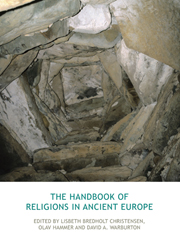1 - Introduction
Summary
THE RATIONALE FOR THIS BOOK
“Religion” is an amorphous concept which has been defined in numerous ways, without any scholarly consensus in sight. Its main features seem to us to be (a) having socially shared activities which bear no direct relation to subsistence, (b) demanding some specific attitude towards death and/or the dead, and (c) generally including a discourse including entities which are beyond this world. Whatever it is, religion seems to be uniquely linked to the human race. It was in Europe and the Middle East that the culture of our immediate ancestors first combined the attributes which are the necessary precursors of religion – burials, plastic art and paintings. It was the religions of groups as diverse as the Greeks and the Scandinavians which seem to have given birth to important traits of our civilization as we define it today. Thus the history and prehistory of Europe is fundamental to the history of the human race and religion – and the history of religion is fundamental to Europe.
Anatomically modern humans, that is, the type of humans to which we belong, arrived on the European continent approximately 40,000 years ago. Their arrival in Europe is associated with the end of the Middle Palaeolithic (which began perhaps 250,000 years earlier in Europe) and the beginning of the Upper Palaeolithic.
- Type
- Chapter
- Information
- The Handbook of Religions in Ancient Europe , pp. 1 - 12Publisher: Acumen PublishingPrint publication year: 2013



